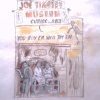1950s
1950
1951
1952
Randwick municipal council begins to remove the last of the remaining shanty towns of Aboriginal and non-Aboriginal residents such as 'Happy Valley'. Some people ignore the council’s eviction orders. Some shacks are finally demolished with the occupants leaving only minutes before. From the 1950’s the last shanty town houses are completely gone.
1954
1957
Pearl Gibbs leaves her position as Aboriginal member of the Aborigines Welfare, an elected position she has held since 1954. She believes that she was excluded from important debates and decisions, especially when the male members went into a bar to drink and discuss, from which as a Koori, she was debarred.











